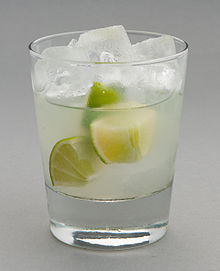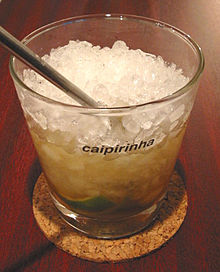Caipirinha
Caipirinha [ kajpirĩjɐ / kajpirĩɲɐ ] is from Brazil originating cocktail of cachaça , lime , sugar and ice . In the German-speaking world, the abbreviation (der) Caipi is also common. In the sense of classic cocktail genres, caipirinha belongs to the sours category . The drink is internationally known and is also on the official list of the International Bartenders Association .
Classically mixed with the sugar cane schnapps Cachaça ( Pinga ) ( Caipirinha de Pinga ), the cocktail is also prepared with vodka ( Caipirinha de Vodka or Caipiroska ) and in southern Brazil with red wine ( Caipirinha de Vinho ) instead of Cachaça. Originally Batida de Limão the fruit meatless prototype for Caipirinha.
Etymology and Origin
The term caipirinha is the feminine diminutive of the Brazilian caipira , which means something like "farmer" or "country egg"; Caipirinha means something like "peasant girl". Despite the name, caipirinha was originally a cocktail of the rural upper class and spread in the big cities after the end of the First World War , while in the interior of the country the sugar cane schnapps is mostly drunk straight.
ingredients
- Cachaça : Sugar cane schnapps is offered in Brazil in all variants - including aged in barrels. The young, just distilled schnapps is colorless, while the yellow or gold colors indicate an aging process. The use of barrique schnapps for caipirinha is not common in Brazil as better quality cachaça is not stored in oak barrels. Local woods are used for storage, which give the cachaça and thus the caipirinha its own touch.
- Limes : In Germany, limes cut into eighths are usually used for caipirinha, while in Brazil slices of lime are usually added. The limes are filled into the glass with their peel and pressed, which is why untreated fruits are preferable. The characteristic lime taste arises mainly when the essential oils escape from the peel when they are crushed .
- Ice : Normal ice cubes are used in Brazil. This will keep the caipirinha cold longer. In contrast, the German bar scene mostly uses crushed ice . Crushed ice has a larger surface area, which means the ice melts faster and the cocktail is watered down faster.
- Sugar : In Brazil, white, refined, mostly finely ground sugar from sugar cane is used, while in Europe brown sugar is preferred.
variants
Based on the classic caipirinha, many other cocktails are offered in a wide variety of styles. These usually differ from each other in that the cachaça is replaced by another spirit .
In Brazil, such mixed drinks are usually also called caipirinha. The various bases for the cocktail are then indicated on the card. Caipirinhas with vodka (called Caipiroschka, Caipiroska, Caipirovka, Caipivodka or Caipirowska ), rum ( Caipirissima ), Aperol / Campari ( Caipirol / Camparinha ), herbal schnapps (Underberg), liqueurs ( Cuarenta y Tres ), Steinhäger. In the Brazilian city of São Paulo in particular , a variant with Japanese rice wine ( caipisake ) is drunk. This can be attributed to the fact that São Paulo (especially in the Liberdade district ) has the largest Japanese community outside of Japan.
(Eg., Or by replacement of one of the other components - with almost any variety liquor or other beverage Caipifruta , the one used in Brazil replacing or combining the lime with other fruits such as passion fruit , kiwi , pineapple or mango ) or adding more - can caipirinhaähnliche alcoholic or non-alcoholic cocktails can be mixed.
With an alcohol-free variant of the caipirinha, the glass is filled with ginger ale and the cocktail is offered as a caipiginger, fresh maker, virgin caipi or Ipanema . Another variation without alcohol is mixed with Red Bull and called Caipibull or Virgin Bull . At Christmas markets , hot caipi is sometimes offered, a hot lime drink (with the lime pieces squeezed out ), sugar and a shot of cachaça.
Individual evidence
- ↑ Why we love caipirinhas ... and so should you. In: eyeforspirits.com. November 14, 2016, accessed November 17, 2016 .
- ↑ Brazilian decree ( Memento of the original dated February 24, 2012 in the Internet Archive ) Info: The archive link was inserted automatically and has not yet been checked. Please check the original and archive link according to the instructions and then remove this notice.


